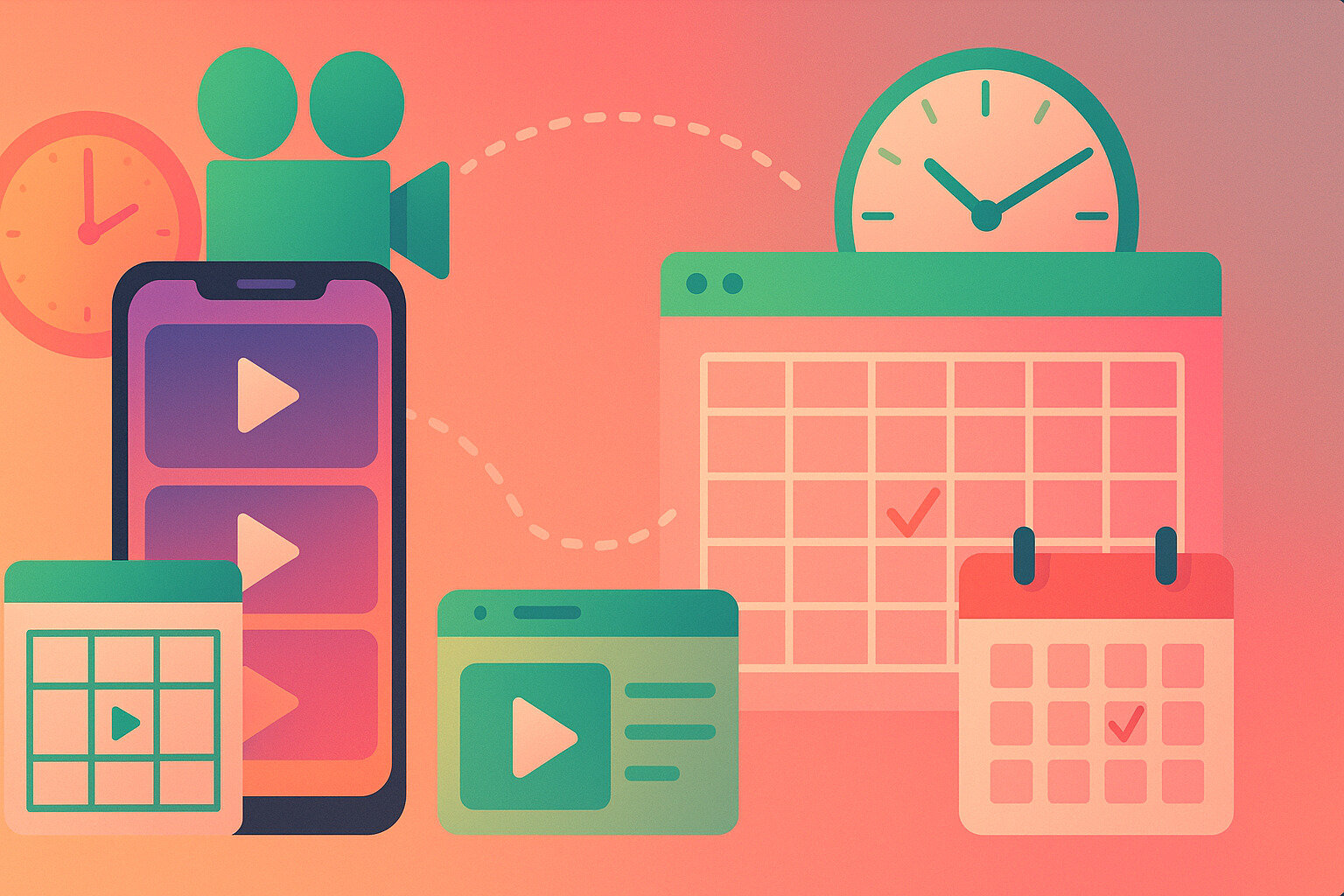Understanding Platform Behavior and Format Priorities
Reels and static posts live in different parts of the platform and behave differently once published. Reels are designed to surface in the Reels feed, trending pages, and often reach users who don’t follow your account. Posts, on the other hand, rely more on follower interactions and appear primarily in your profile grid and followers’ home feeds.
The way users scroll also affects how content is consumed. Reels are full-screen, sound-on experiences built for quick swiping and immediate attention. Posts, especially image carousels, are viewed more casually with slower scrolling and less pressure to capture attention instantly.
Because of these platform mechanics, scheduling Reels must consider discoverability and timing with higher precision. The visibility window is narrower and depends more on interaction velocity within the first few hours.
Matching Content Style to User Expectations
Users approach Reels differently than they do standard posts. While a post might be seen as a space for polished visuals, thoughtful captions, or curated branding, Reels invite energy, sound, and a faster rhythm. People often expect humor, tutorials, or trends—not static updates.
This shift in tone means that scheduling Reels must take into account cultural moments, viral trends, and audio timing. A well-timed Reel using a trending sound can outperform a perfectly crafted post that misses the moment.
Scheduling tools may not catch fast-changing trends. That’s why creators often delay scheduling Reels far in advance. The format demands reactivity. Reels perform best when they’re timely and feel connected to what’s happening right now.
Prioritizing Timing Over Frequency
Posts benefit from consistency. Accounts that publish posts regularly—even at slower intervals—can build momentum over time. Reels rely more on specific timeframes when users are active and likely to engage fast.
When planning a Reel schedule, attention must be paid to active hours, local audience habits, and even time zones. A high-quality Reel published at the wrong time might not make it into the explore feed at all.
Some creators have seen success posting Reels at unconventional hours—early mornings or late evenings—when competition is lower. These patterns vary by niche, making it essential to experiment rather than rely on general scheduling habits.
Leveraging Audio and Trend Cycles
A key feature of Reels is the integration of audio. Songs, sounds, or voiceovers often drive the trend and tone of a video. Posts don’t offer this creative tool in the same way. That makes timing Reels not only about visuals, but also about catching the trend at its peak.
When a sound begins to trend, there’s usually a two- or three-day window before it becomes overused. If a Reel is scheduled too late, it can feel outdated, no matter how creative the visuals are.
Because trends change rapidly, many creators opt to upload Reels manually to keep their content fresh. Scheduling a Reel even two days in advance can miss that critical timing sweet spot for audio trends.
Balancing Spontaneity with Strategy
Posts are often part of a broader brand narrative. A campaign might include a Monday post to introduce a product, followed by more details on Wednesday, and a testimonial or user photo on Friday. This cadence works well for grid curation and storytelling.
Reels, in contrast, often work better when they break the script. A random behind-the-scenes clip or unscripted reaction can outshine a carefully storyboarded Reel. That means creators have to make room for spontaneity—even in a planned content calendar.
A strategy that’s too rigid won’t work for Reels. While planning is helpful, scheduling needs to leave space for last-minute edits or real-time posts inspired by audience reactions or sudden trends.
Adjusting Analytics and Measurement Goals
When measuring success, posts usually rely on likes, comments, and saves. Reels are more about reach, watch time, and shares. These differences shift how scheduling should be approached.
A post can build slow engagement over days. Reels, however, are judged quickly. If the first few hours don’t generate views and likes, the platform may stop pushing it further. Timing, therefore, becomes part of performance.
Scheduling Reels without understanding these patterns can lead to missed insights. Analyzing when past Reels hit their peak can help shape future posting windows more accurately than simply guessing or following post habits.
Building Different Creative Pipelines
Producing Reels often requires video editing, music syncing, and timed text overlays. That’s a different creative process than designing static posts or even carousel graphics. Reels need more tools, more testing, and often more revisions.
This production pipeline means Reels benefit from a content library that allows flexibility. Creators often batch film Reels but wait to edit or schedule based on trend relevance. That’s different from posts, which can be designed and queued well in advance.
Trying to apply the same creative calendar to both Reels and posts can create stress or underperforming content. Reels need their own timeline—one that allows for spontaneity but still aligns with campaign goals.
Recognizing How Platforms Push Video
Instagram and Facebook often give Algorithmic Decisions to Reels over posts, especially newer accounts trying to grow. But this push doesn’t guarantee success—it simply opens the door.
To take advantage of this window, Reels must be scheduled when audiences are likely to watch, rewatch, or share. Unlike posts, which may slowly build traction, Reels either gain speed or stall early on. This pattern shapes how and when they should be published.
This means analytics must be monitored closely. If one Reel performs well at a certain hour, that insight should be used to time future content. A static schedule won’t deliver the same results as one tuned to past performance.
Integrating Community Feedback in Real-Time
One advantage of Reels is how quickly users react. Comments, shares, and remixes often start within minutes. This gives creators a chance to respond fast, update captions, or change the next Reel’s direction based on immediate feedback.
Scheduled posts don’t always allow for that flexibility. They publish as planned, often with less room for updates or rewrites. With Reels, creators who stay active after posting often get better engagement through replies or comments.
This engagement loop can guide future content ideas. A funny comment might inspire the next video, or a popular suggestion might become its own Reel. Building space into your strategy to respond quickly can shape better outcomes.
Aligning Reels With Business Goals
While both Reels and posts can support campaigns, they fit different roles. Reels often act as attention drivers—designed to attract new eyes or spread brand moments. Posts serve more as information holders—supporting products, updates, or long-term messaging.
This difference should be reflected in how they’re scheduled. Reels might lead the charge on launch day, followed by posts that provide deeper context. Or, a post might tease a feature, with a Reel offering a playful visual of it in action.
Understanding how each tool plays into the bigger picture helps teams avoid scheduling conflicts or redundant messages. Instead, each channel supports the other, forming a stronger promotional rhythm.
Timing Reels With Strategy and Flexibility
Reels have their own pulse. They’re faster, trend-driven, and rely more on momentum. Scheduling them requires more than simply choosing a time slot—it calls for awareness, adaptability, and a willingness to adjust based on what’s working.
Posts remain a core part of strategy, but Reels need their own space. Treating them with the same logic won’t deliver the best results. Instead, the best outcomes come from understanding what sets them apart and building a rhythm that reflects their energy.
When teams combine solid planning with the flexibility Reels demand, their campaigns feel more alive, more relevant, and more in tune with how people scroll, tap, and react every day.











No responses yet